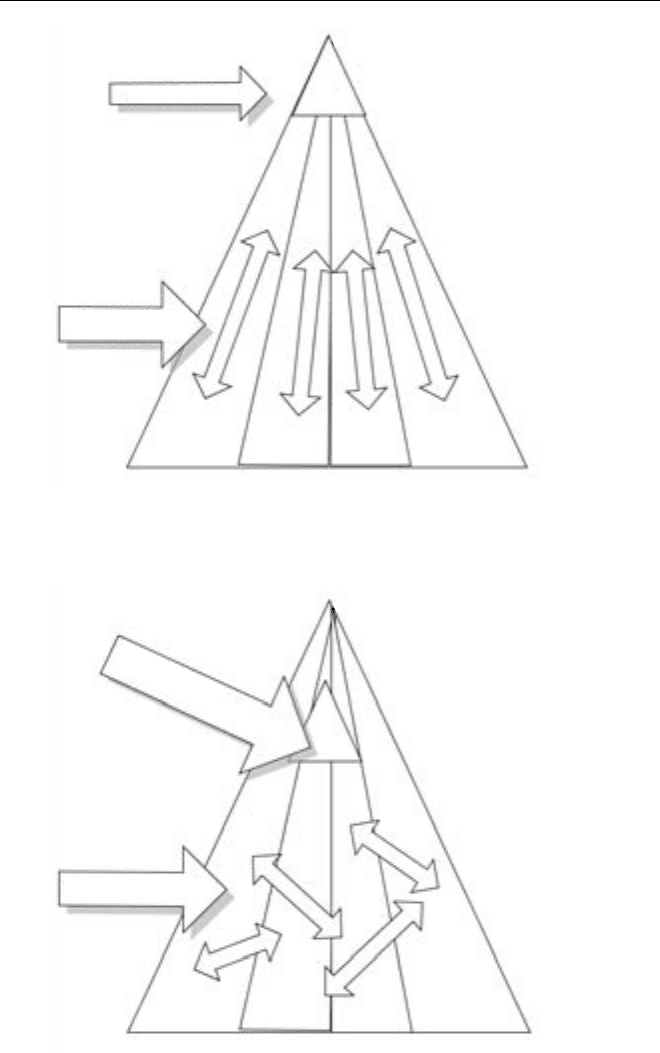Phillips D., Young P. Online Public Relations
Подождите немного. Документ загружается.


136
How social media
impact on strategy
As we have seen, the power and ever-growing influence of the internet
and social media across all aspects of organizational development are re-
markable. Now we need to look at ways in which communications strategies
can be re-evaluated, redefined and developed in order to succeed in this
new environment.
When one looks at the profile of most organizations in websites, on mobile
phones, through digital television or in online media, there is one striking
impression. It’s a mess: inconstancies; for most, appalling search engine
optimization; orphaned legacy content exposed online; lack of continuity
between platforms and channels; intrusion of competitive or derogatory
content; o�en stilted and static information on websites that are years out of
date; a culture of not sharing in a era of sharing; and so the issues continue.
Most organizations do not have a corporate internet strategy.
With the imminent prospect of 50 per cent growth in online retail, similar
growth in online public purchasing, and more than 70 per cent of business-
to-business purchasing decisions mediated by the internet, there is an over-
whelming case for improving capability to strategically manage online
presence, interactions and stakeholder relations by organizations.
Public relations, at its most senior level, has to establish board commitment
to online strategy. Its significance is greater than executive board roles such
15

How social media impact on strategy
137
as human resources, marketing, product development and supply chain,
because each of these is deeply dependent on an effective internet strategy.
In addition the web management functions and IT have to relinquish their
grip on design functionality and on data. These are now o�en the stuff for
building relationships.
In corporate communications strategy, there are big changes afoot. The
readers of a book like this may come from a range of practices, from the
most senior corporate manager to a first-year student of PR. This poses a
problem. At one level, we are discovering that the impact of the internet,
because of its mediation in transparency, porosity and agency, richness and
reach, is changing the nature of economics, politics and culture. It is changing
the way organizations are managed and is changing the management of
activities. In part these are subjects for management titles, but, because the
internet is so significant in communications and in relationship mediation,
this change is a PR issue from top to bo�om. At the other extreme, the sig-
nificance of a Facebook profile on a potential employee’s reputation brings
home the reality of the internet to the student.
The platforms and channels and contexts and their many applications
for communication and relationship building affect practitioners, the
practitioner community and practitioners’ organizations. PR should play
a central role in this transformation, but this requires both a thorough, pro-
fessional understanding of what is happening and an influential voice at
the core of strategic development. One of the most effective ways for prac-
titioners to gain acceptance for their work and ideas is through detailed and
professional planning.
In its simplest form, PR management consists of planning, execution and
monitoring. In traditional PR, li�le more is needed to represent a client than
a clear brief, accurate data and sufficient practitioner time – leavened, of
course, with a creative approach to knowledge transfer. Mostly it is a two-
step (press agency, lobby or event-based) activity. It is assumed that human
planners (seldom even using formalized planning and risk management
tools) will generate the ‘best’ network of activities. The execution is expected
to be the same as the plan – but this is seldom what actually happens! There
is a fundamental difference between having a plan and executing it. In-
evitably, emerging events will alter the execution, and never more so than
when using social media.
The one thing we know for sure in 2009 is that we do not know what
communication platforms, channels and contexts will be relevant in 2010 or
2020. Our experience over recent years shows that looking even a relatively
short way into the future is beyond all but the most creative and informed
minds. The rate of change will continue to be extremely rapid; although we
cannot say how the way people communicate will change, it is still vitally
important that we plan for that change.

Building blocks for online PR
138
Who, for example, would have predicted in 2003 that in 2008 (only
five years later) broadcasters, newspapers and magazines would accept
(solicit) video news clips from the public to publish on their own online
TV channels. Equally, who would have predicted that chief executives of
major corporations like Tom Glocer, the CEO of Reuters, would open up
their thinking on blogs, knowing that they would face very open and o�en
critical and public exchanges?
Part of strategic planning for corporate public relations requires a sig-
nificant element to plan for change. For the practitioner this means that com-
munication and relationships internally and externally will consider how
the internet will affect five elements of corporate strategy development:
Business purpose. Will it be changed by public environments, platforms
for communication and channels for communication in a foreseeable
time frame?
Organizational goals. Will they be changed as people’s lifestyles change?
Do the devices people use to access information and interact with others
affect the organization, and will emerging channels for communication
influence the goals or access to them?
Strategies for reaching each goal. There is almost an inevitability here. The
strategy for reaching even simple goals will be changed and therefore
have to be kept under review.
Action plans to implement strategy. The PR plan (as opposed to PR cam-
paign) might have a life of as long as a year.
Monitoring plan implementation. The range of ways that business strategy
can be monitored is growing rapidly and the shi�ing eddies, currents
and tides of commercial influences brought about by communications
technologies need close monitoring.
There are now a number of organizations that use social media to influence
more traditional media.
Andy Lark, Vice President Global Marketing at Dell, is on record as saying:
The social media stuff is probably the most important thing we do today, from
a marketing standpoint. The other elements of marketing mix have sort of
become more and more transactional and more and more tactical in nature.
Social media stuff is much more strategic. . . Use social media to power the
fundamental of the business. That’s what we’re focused on.
HSBC Bank changed its strategy of ending interest-free overdrafts for
students leaving university in 2007 when thousands of students on
Facebook threatened to boycott the bank.

How social media impact on strategy
139
The context and environment in the use of platforms and channels affect
the planning of strategies and tactics.
The changing media environment is changing social habits. Of course,
buying online is a significant change in behaviour; it now common to see
a computer in the same room as a television, both working at the same
time. The great news about a newborn child is flashed by SMS through the
family network, while our daily agenda is dictated by an enterprise-wide
diary on an intranet. The news about a fellow student’s post-graduation
world travels is on Facebook as the journey happens. Once, everyone wore
a watch; today many people will take out their mobile phone when asked
the time.
CASE STUDY: THE INTERNET AS AGENT OF
SOCIAL CHANGE
In the United States large numbers of internet users hold such strong views about
their online communities that they compare the value of their online world to
their real-world communities, according to the sixth annual survey of the impact
of the internet conducted by the USC-Annenberg School Center for the Digital
Future. (An ‘online community’ is defined as a group that shares thoughts or
ideas, or works on common projects, through electronic communication only.)
Among a broad range of findings about rapidly evolving methods of online
communication, the 2007 Digital Future Project found that 43 per cent of internet
The media are aware that journalism’s strategic model has changed
too. Darshna Soni, a reporter for Channel 4 News, wrote in 2007: ‘Citizen
journalism has completely changed the way we cover the news. . . citizen
journalism can be very powerful, a way for people to contribute to and
even influence the news agenda, surely no bad thing?’
The effect of social media outreach on strategy can be felt in many areas
of the media, government, business and academia.
On a shopping trip to Oxford, 16-year-old Laurie Pycroft staged an
impromptu protest to counter a much larger demonstration by Speak, the
group that led a high-profile and partly successful campaign to halt the
building of a new animal research laboratory in Oxford in 2005. Pycroft
and two friends chanted ‘build the lab’ and scrawled a placard reading
‘Support Progress, Support the Oxford Lab’. They were shouted down
and went home. He blogged about the experience, was surprised by
the volume of support and so built a website that was receiving 300 hits
an hour within two weeks. After a short campaign, and a shift in public
sympathy that spurred government action, the new lab was built and is in
use today.

Building blocks for online PR
140
users who are members of online communities say that they ‘feel as strongly’
about their virtual communities as they do about their real-world ones.
The Digital Future Project also found that involvement in online communities
leads to offline actions. More than a fifth of online community members (20.3
per cent) take actions offline at least once a year that are related to their online
community.
Source: http://psychcentral.com/news/2006/11/29/the-internet-as-agent-of-social-change/
(Accessed July 2008).
We are aware that internet-mediated communication channels now form an
integral part of managing relationships with large parts of the population,
not least employees at work and at home, customers, suppliers, business
partners and journalists. Indeed, for many it is now the dominant protocol
for interaction.
THE ESTABLISHED ORDER UNDER THREAT
The change is happening, but what makes it hard to grasp is that the internet,
and notably social media, is shaking many long and deeply held customs
and beliefs. As we saw in Chapter 1, the established order is under threat.
The idea that an organization is the nexus of contacts, espoused by Coase,
is now significantly challenged by what we know of how communication
inside (and to the outside) has changed.
1
At one time organizations were
managed from the top down in departmental silos. Inter-departmental
communication had to take place via a senior manager (Figure 15.1). The
advent of e-mail, instant messenger and other channels for communication
has changed that (Figure 15.2). Anyone can communicate with anyone.
This means that any group of people in the organization can come
together to achieve their objectives, and on occasion those objectives will
challenge senior management. The nature of network communication inside
organizations changes the dynamic of management. Decisions can be made
faster and can be made without reference to the senior management team.
Professor Feng Li at Newcastle University Business School articulates the
model like this:
At the organisational level, a wide range of organisational innovations have
been introduced across different sectors, resulting in both incremental and
radical changes in the structures, processes, work organisations and inter-
organisational relations of many organisations. From a structural perspective,
for example, despite repeated predictions about the demise of the hierarchy

How social media impact on strategy
141
Figure 15.1 The traditional organizational structure
Figure 15.2 The changing organizational structure
[fc]Figure 15.2[em]The changing organizational structure
Networked communication
Dominant coalition
can move
[fc]Figure 15.1[em]The traditional organizational structure
[!lower case “control management”!]
Dominant coalition
Command and control
management

Building blocks for online PR
142
Managing internal relationships, and by that one can only mean a strategy
for optimizing the environment for empowerment, availability of platforms
for communication and awareness of threats and opportunities available
through using different channels for communication, is now high on the
internal PR practitioners’ job description.
At a PR functional level, the political economy approach to media and
communications described by Andreas Wi�el has evaporated.
2
It is no
longer credible to regard culture, communications and media as objects
that carry symbolic value that can be produced, distributed and consumed.
The production and consumption of media, culture and communications
were once viewed as being distinct practices (especially in newspaper
publishing), but in an era of citizen journalism (and in this context we
can include internal e-mail as well as the posting of millions of photos by
millions of people in the United Kingdom on Facebook), practices such as
blogging, wiki-editing, video production and sharing mean the consumer
of editorial content is also the producer. In traditional theory, those who
controlled the means of production and distribution of media, culture and
communications possessed greater power than consumers, but now the
and the continued search for alternative organisational configurations, today
almost every large organisation remains hierarchical. They have become
flatter, more flexible, more responsive, and they increasingly deploy project-
based or virtual teams to address traditional problems associated with the
hierarchy, but so far nobody has been able to identify an organisation that
is not a hierarchy. This is not to say, however, that the characteristics of the
hierarchies and the way these hierarchies work have not changed. The wide-
spread adoption of ICTs has significantly improved the transparency of the
entire organisations to business leaders and managers. This on the one hand
leads to further centralisation of power, but at the same time it enables senior
managers to have the confidence to delegate responsibilities and activities to
operational managers and frontline employees without worrying about losing
central control. The shape of the organisation may have not changed beyond
hierarchies, but the way the new hierarchies work is radically different. ICTs
have enabled some organisations to resolve conventional problems inherent
in the hierarchy, allowing radical structural changes to take place within the
parameters of the hierarchy. These changes are increasingly reflected in the
changing principles of organisational designs. (Source: http://professorfengli.
blogspot.com/2008/05/second-e-business-boom-how-internet.html, accessed
October 2008.)
In the meantime we have seen how these changes are affecting other types
of organizational structure. The influence of Facebook for UK librarians
was written up by Jane Secker for LASSIE (Libraries and Social Software
in Education) in 2007 and demonstrates how a number of communities
provide a new infrastructure for the sector.

How social media impact on strategy
143
balance of power has shi�ed in favour of the consumer. In this world, inter-
ventions by organizations to develop business have to be at a strategic level
because almost everything they do is under the intense and critical gaze of
the growing online community and of those with which it interacts.
Potentially every word online is open to scrutiny by a billion people in
this generation and the next. The theory is that the power of a minority will
always be under scrutiny, whether that minority is a government or the
local cricket team wiki. Equally, this scrutiny can at any time now or in the
future be used to mediate knowledge and interaction. In discussing this in
detail in Chapters 3–5, we noted that there are three major elements: the
increased transparency of organizations, the extent to which organizational
boundaries are breached – which increases porosity – and the extent to which
people and technologies act as agents for transaction and interaction.
Until recently it was (relatively) easy to offer content to a wide audience
through a strong media sector. Targeting messages at a range of print titles
or a few dozen TV and radio channels was manageable. Today, reaching
an audience is more complex. The proliferation of new channels presents
a problem, but this is magnified by the rapid expansion in the range of
platforms that can carry reputational messages.
One can speculate that most press relations managers are not fully aware
of the extent of the coverage of their stories. In fact, it is probable that, even
for the most knowledgeable search specialist, tracking all stories in all media
as they are interpreted in pasting from channel to channel is impossible. But
for the informed few in interested groups, their knowledge will be nearly
complete.
Each platform offers a different experience, which means that reception
and interpretation of the same message may be perceived differently at the
point of consumption. The context for relationships is now more important
in strategy development. For example, on-demand TV has a wider and
more fragmented set of social uses than before. It is becoming increasingly
interactive, and viewers themselves are gaining the ability to both time-shi�
and repackage content to meet their individual needs and life pa�erns.
3
Once watching television in the garden was not easy; today it is a simple
ma�er of using a wifi-enabled laptop.
Equally, it is unse�ling to realize that even in a traditional medium such
as television, the PR message may be edited out by the consumer! A news-
paper article or magazine feature might once have been read at home, on
a train or at work. But the reader needed to have the publication to hand.
Now the article is available wherever there is a PC, laptop, mobile phone or
TV. The publication is always to hand on an array of platforms.
This means that even older forms of mass communication reception are
now changed. This range of platforms and frequently convergent channels
for information exchange means that relying on communication ‘silver
bullets’ to reach any segment or group of people is no longer enough.

Building blocks for online PR
144
The compounding effect of new channels such as Facebook, YouTube
and Twi�er, plus wikis, podcasting and all the rest, adds complexity to re-
lationship and behaviour motivation planning. Even the channels can be
part of the message; the use of an un-editable PDF file suggests that further
debate is not encouraged; if the same information is carried on a blog, the
implied message is entirely the opposite, with content development by the
audience positively encouraged.
In addition, as we have seen, online media encourage people to actively
bookmark their articles and share them with others. Circulation of stories
from the Daily Telegraph, South Wales Echo or Heat Magazine can be shared
with friends and the world using common bookmarking sites (typically, at
time of going to press: Delicious, Digg this, Stumbleupon, Newsvine), o�en
with user-created tags and possibly including comments of the publication’s
site and/or the sharing site. O�en the commentary and sharing is about
content provided by a press office.
The evolution of the internet from a platform for data communication
to an application that encourages data manipulation (not just through
human intervention but by internet-enabled technologies that act as agents
– internet agency) is now very apparent. This would suggest that a compre-
hensive operational strategy should consider how best to harness this
power of sharing, and internet agency.
The need for timeliness of intelligence about what is happening is, as for
many other PR activities, already changing the news monitoring strategy.
For example, a web widget that combines RSS with automated keyword
search (and is able to take information from web pages that do not even
have RSS feeds) embedded into a blog, wiki or website can be the equivalent
of an old-fashioned press clipping bureau. It is completely automated and
can monitor in near real time newspapers and magazines, radio and TV
sites, as well as social media. The cost is low (o�en free) and not only dis-
intermediates the clipping bureau but provides a newswire and clipping
service to the general public, subsuming an area of PR practice once the
preserve of the PR department or agency. Perhaps the strategy has evolved
into being the facilitator.
There are a lot of people who provide a range of RSS news monitoring
services to the general public. Dave Cross of Director, Magnum Solutions
Ltd, has http://dave.org.uk/newsfeeds.
The opinion feedback that newspapers once had in the form of le�ers to
the editor now includes e-mail, online comment, recorded comments
and much more. Monitoring such interactions is now important. The
strategic decision to focus on online monitoring, o�en at the expense of

How social media impact on strategy
145
traditional paper clips, is a big change and no doubt some print coverage
will be missed in some organizations, but if its reach is limited to walled
gardens of subscriptions or print-only content, it may be deemed of lesser
significance.
Things are changing, but experience shows that new media do not kill
off old media. Old media tend to adapt. Newspapers are now also broad-
casters, the BBC is using Twi�er (h�p://twi�er.com/bbcnews) and inter-
personal telephone conversations include text, pictures and video from
home phones, computers using Skype and mobile devices. Legacy channels
also remain available long a�er they fall out of fashion (eg fax and Usenet)
and/or morph into new forms (eg Google Groups) and should not be
forgo�en.
Internet strategies at a corporate level, functional level and operational
level are, we have now established, all changed because of the internet ‘new
PR’ effect.
LOCAL VERSUS GLOBAL COMMUNICATION
There are further devils in the detail. The nature of local versus global com-
munication online is a consideration.
There is a notable tendency for publics (or market segments or stake-
holders) to give way to online user-generated social/consumer segments.
Here, users gravitate to each other and engage on their own terms. Very
o�en these users do not conform to the profile identified by the originating
organization that once might have thought it ‘owned’ the product or brand.
Online community portals offer rich evidence of this tendency. Groups form
that defy their market geographies, age profiles, incomes and anticipated
interests.
Using a Microsoft search analysis engine (http://adlabs.msn.com), it
is possible to identify the use of a website by social demographic. This
showed the demographic profile of Wikipedia as being mostly female
oriented, with a ratio of 30 per cent male to 70 per cent female users;
it had an age distribution of 27.2 per cent 25–34-year-olds, 26.8 per cent
18–24-year-olds, 23 per cent 35–49-year-olds, 13.2 per cent over 50 and 9.8
per cent under 18.
It may come as something of a surprise to find that nearly one in 10 users
are children, and it is interesting to note that the most inquisitive people
are 24-year-old women.
Using the same methods one finds that a quarter of the people interested
in Formula One are women aged 18–34 and 36 per cent of people using
Handbag.com are men aged 25.
